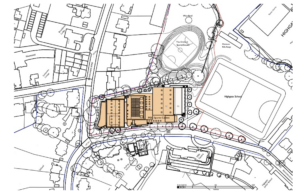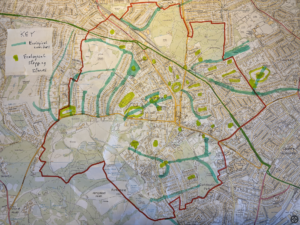Local resident and veteran environmental campaigner Nicky Gavron warns Highgate about the impact of Highgate School’s development proposals.
The work of the Highgate Neighbourhood Forum has been very valuable in regard to this topic, especially the way you have managed to get a basement policy into Haringey’s local plan and your contribution to the Biodiversity Action Plan. What I address here is the impact that the Richards Music Centre, Temporary Classrooms, and Mallinson Centre and its flood basin would have on the hydrology and ecology (including biodiversity) of Tatum Field, the woodland area, Junior Field and wider area.
You may already be aware of the unique hydrogeology of the Bishopswood area. It is characterised by a network of underground springs and surface streams in ditches. This is because the whole area has what is called a claygate layer which is between 5-15m before you get to solid London clay. Claygate is made up of different layers of clay, silt and fine grain sand. Groundwater flows easily through the sandy layers which means the whole layer has very high water table. In some areas groundwater is as shallow as 0.30m bgl. Extreme weather events can mean this groundwater layer gets saturated and rises to the surface and combines with surface runoff to cause surface flooding and a boggy landscape.
This is where trouble begins and we’re in for more trouble, because we’ve just had the wettest 18 months since records began. Without doubt, with the impact of climate change, more is on its way. If you live around there, you know about all this because the gardens are water-logged and flood when there is heavy rainfall. Tatum Field – the school’s playing fields behind our gardens – is often unusable during winter months.
We also know about this because we’ve all got shallow Victorian coal cellars, which flood in heavy rainfall. This is because there are two sandy layers, called aquifers: one just below the floor of the cellars and one deeper down. Both run downhill and under or close to the Mallinson Centre, where the school is proposing to create two basement areas. These aquifers, like all the other springs and streams in the area, end up on the Heath. This is why the City of London commissioned a survey in the noughties because they were concerned about the impact of groundwater changes and flood risk on the ponds, lakes and water regime of the Heath.
Basements in properties which sit on this complex and vulnerable water system have already been proved to be a very bad idea. Dr Haycock of Haycock Environmental Consultants (who was technical advisor for the City of London surveys) was employed by residents on the south side of Broadlands Road to look at applications for basements. He has demonstrated the impact of proposed deep basements (around 4 or 5 metres in depth – which is at least the depth of the proposed basements of the Mallinson and Richards Centres) and how these basements, together with piling, can act as dams. These dams interfere with groundwater flows causing property subsidence and damaging the ecology of the area. So far, for this reason, no basements have been given permission.

Now, residents are being advised on the proposed Mallinson basements and the flood basin, by both Baxter Associates Structural Engineers and Dr Haycock. They have advised us that the school’s consultants have not surveyed groundwater conditions around the proposed developments across the whole site of the Tatum and Junior Fields, and the properties around. They therefore have no understanding of the impact of the proposed development.
The school are already concerned by the surface flooding and runoff. Indeed, the Environment Agency map shows that the corner of Broadlands Road and Bishopswood Road is considered “high risk” from surface water flooding because the drains would not cope. They sometimes already do not cope. The school has come up with the idea of creating a flood attenuation basin to deal with the additional surface runoff which would result from the redevelopment. However, they have not yet accounted for groundwater.
In original plans, it was called a sunken sports pitch/flood basin. Now the School are saying it is just a flood basin. It is currently planned to be 50 metres wide, located behind the houses next to the Mallinson Centre and involves taking down a substantial section of woodland – trees store water and their roots stabilise the ground, so removing them is bound to be risky.
The School intends the sunken attenuation basin to store excess water and release it slowly into the combined drains and sewers. According to Baxter and Haycock, structurally this will not work: it would disrupt the delicate balance of groundwater in the area and have an impact on the ecology. This is before either of them have considered the additional impact on groundwater/surface runoff of the new Richards Centre’s basements and (for up to 10 years) the hard surface for the Temporary Classrooms located on the Junior Field.
Without employing professionals to understand and monitor groundwater across the wider site over an extended period, the school won’t be able to come up with designs that are viable and don’t disrupt the delicate balance of groundwater in this area.
The Ecological value of the school’s land.

The land I’ve been describing forms a green corridor which runs from Tatum Field below Highpoint, along the woodland, into the Junior Field, across the Senior Field, down to Hampstead Lane and across to the Heath. The Heath itself is a Site of Metropolitan Importance for Nature Conservation. It contains biodiversity hotspots and an SSSI at Kenwood
Highgate School playing fields benefit from woodland (The Orchard) as well as the last surviving ancient hedgerow in Highgate which includes several veteran oaks of great ecological value. All this land is Metropolitan Open Land. The risk to biodiversity of damaging these slow growing habitats is obvious.
The hydrogeology of the area, which we’ve already discussed, means that there are many boggy habitats, vital for numerous species to flourish.
Nature knows no boundaries: My garden on Broadlands Road is teaming with wildlife including bats, stag beetles, great crested newts and a range of birds (only yesterday a lesser spotted woodpecker was seen outside the back window). It is highly likely that these threatened species are to be found also in the trees, hedgerows and boggy areas on Highgate School’s land, including the fringes of the woodland which has a deep ditch with a stream in it running around it and down to the Mallinson Centre.
Some people along Broadlands Road have found hedgehogs in their gardens and as Hampstead Heath has a large hedgehog population, it is vital for their future (as well as many other species) that they can travel along green connected routes, which is one reason why the School’s estate is so important.

The School’s land at the huge Far Field is part of another ecological corridor which leads from the Golf Course, through the Far Field and down to Kenwood. North Wood at Kenwood is a Site of Special Scientific Interest and important for foraging. The school is proposing to put Astro turf on the Far Field. Even if Astro turf is permeable, the plastic in it will harm the soil and prevent similar foraging to that which takes place at North Wood. This is why Highgate Neighbourhood Forum’s citizen science project is so important.
The school’s ecology report says that the school’s land is of “negligible ecological and biodiversity value”. Since my garden has, as I’ve already said, great crested newts, bats, stag beetles and a wide variety of birds and is a few metres away from the Tatum Field and the woodland, I don’t understand how that could be possible.
So we all have to monitor and collect data on the wildlife and habitats and prove what the area contains and its potential, however poorly it has been managed in the past. We can do this by joining the Citizen Science Project which HNF is spearheading and which we really hope you will participate in.
Nicky Gavron and Katie Machin (taken from Nicky’s presentation to the HNF AGM May 2024)




The Ecological value of the school’s land. – would it be possible to provide a high definition version of this potentially interesting graphic? The copy included in the mailing is illegible.
Sorry Tony – these are all the graphics we have. More should emerge after the workshops at the school this summer – we will post as soon as we have anything.